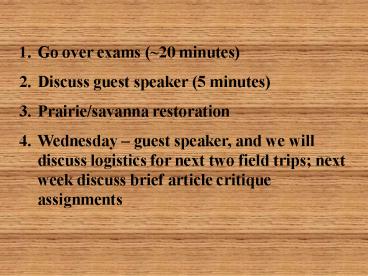Go over exams 20 minutes - PowerPoint PPT Presentation
1 / 45
Title:
Go over exams 20 minutes
Description:
Wednesday guest speaker, and we will discuss logistics for next two field ... Wild lupine. Restoration Savanna. It's not all rosy, ... – PowerPoint PPT presentation
Number of Views:34
Avg rating:3.0/5.0
Title: Go over exams 20 minutes
1
- Go over exams (20 minutes)
- Discuss guest speaker (5 minutes)
- Prairie/savanna restoration
- Wednesday guest speaker, and we will discuss
logistics for next two field trips next week
discuss brief article critique assignments
2
Mean 85
3
(No Transcript)
4
(No Transcript)
5
(No Transcript)
6
(No Transcript)
7
(No Transcript)
8
(No Transcript)
9
(No Transcript)
10
(No Transcript)
11
(No Transcript)
12
(No Transcript)
13
(No Transcript)
14
Sandy, glacial lake plain soils
Eastern prickly pear cactus Opuntia humifusa
15
Source Ohio DNR
16
Oak Savanna1 4-43 trees ha-1 black/white oak 51
land area
1 Brewer, L.G., and J.L. Vankat. 2001. The
vegetation of the Oak Openings of northwestern
Ohio at the time of Euro-American settlement. Map
and text. Ohio Biological Survey, Columbus, Ohio.
17
Oak Woodland gt43 trees ha-1 black/white oak 23
land area
18
Wet prairie 0-1 trees ha-1 27 land area
19
Ecosystem Changes 1860s-Present
- Fire suppression
- Livestock Grazing
- Logging of oaks
- Drainage alterations
- Conversion to pine plantations
- Agricultural clearing, urban development
20
Red maple 600 trees ha-1
Black cherry 80 trees ha-1
Oaks 180 trees
ha-1 (41o33'00"N, 83o52'00"W)
21
Red maple 480 trees ha-1
Black cherry 80 trees ha-1
Oaks 0 trees
ha-1 (41o33'00"N, 83o51'15"W)
22
(No Transcript)
23
Karner blue butterfly http//www.wbu.com/chipperwo
ods/photos/karner.htm
24
1984-2003 land cover change
Purple residential
25
0.02 of original oak savanna remains
Nuzzo, V.A. 1986. Extent and status of Midwest
oak savanna presettlement and 1985. Natural
Areas Journal 66-36.
26
(No Transcript)
27
(No Transcript)
28
(No Transcript)
29
RESTORATION OBJECTIVES
- Reverse trend of ecosystem decline by
reestablishing historical tree structure and
reintroducing approximate historical disturbance
regime to the contemporary degraded ecosystems - Specifically, to reestablish oak savanna, oak
woodland, and wet prairie ecosystems in areas
where they historically occurred but do not
presently occur
30
How to do this? (a) Determine reference
conditions U.S. govt. land surveys, old trees,
remnants, fire scars where possible (b) Choose
sites potential for ER large oaks, block
drainage ditches, soil survey (c) Prescribe
treatments (fire, thinning)
31
(No Transcript)
32
Pre-treatment September 1998
Post-treatment July 2002
(41o32'45"N, 83o51'15"W)
33
Pre-treatment September 1998
(41o32'50"N, 83o51'15"W)
Post-treatment July 2002
34
24 restoration plots
298 total species, 19 Ohio listed
35
Woodland Flora
36
(No Transcript)
37
Post-treatment (2002)
Denotes significant difference at Plt 0.05
(paired t-test) Error bars represent 1
standard deviation
38
Restoration increases native species richness
39
Meadowsweet Restoration Wet Prairie
Wild lupine Restoration Savanna
40
- Its not all rosy,
- Exotic species not always, but often, problems
- Fire timing not consistent with reference
- Unclear if missing certain species
- Small sizes
- Success of Karner blue reintroduction
- Use of land?
41
(No Transcript)
42
Puccoon Columbine Aster
43
Species richness (mean ? 1 SD)
Lawn Native Plant Area 1.3 ? 0.6
9.7 ? 2.1
t 9.4 P lt 0.01
44
(No Transcript)
45
(No Transcript)































